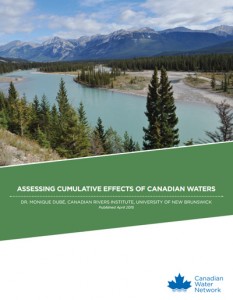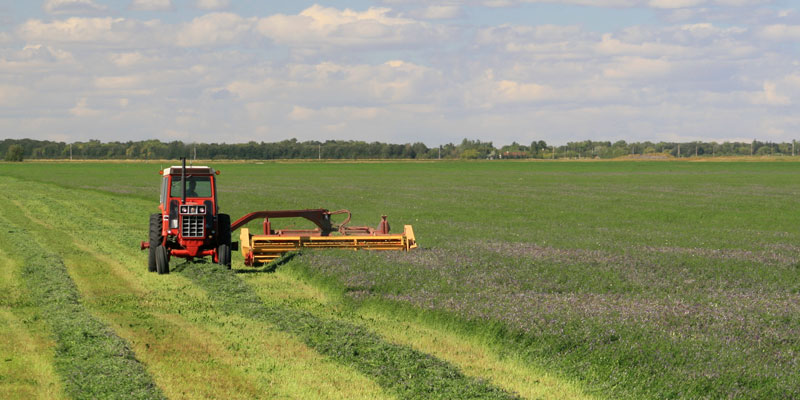Development of The Healthy River Ecosystem AssessmenT System (THREATS) for Assessing and Adaptively Managing the Cumulative Effects of Man-made Developments on Canadian freshwaters
Principal Investigator - Dr. Monique Dubé, Adjunct Professor, Canadian Rivers Institute, University of New Brunswick, 2008 - 2012

Challenge
The state of the environment is constantly being altered as a result of both natural and human driven events. These effects are not always caused through direct means; more likely they are cumulative effects. Assessing the cumulative effects of development on a watershed is challenging, requiring consideration of the types and intensities of development on the landscape over space and time. It also requires measurement of indicators of aquatic conditions, including the quality of water and sediment, and the diversity, abundance and health of biota. Indicators of aquatic condition must be compared with benchmarks to determine if changes have occurred, both to direct further investigation into potential mechanisms and causal sources and to identify to decision-makers the need for follow‐up. There is a lack of a clear, field-tested process for aquatic cumulative effects assessment (CEA) over time at watershed scales.
This project, led by Dr. Monique Dubé, addressed the issue of assessing, predicting and managing the cumulative effects of multiple stressors affecting the quality and quantity of our surface waters. The objective was to develop a framework for assessing the cumulative effects of man‐made developments on Canadian watersheds. This will lead towards implementation of CEA in a way that reduces the project-specific focus, providing a regional basis to answer key questions of concern, identify opportunities for cost-efficiencies, and reduce duplication of effort in existing monitoring requirements.
Project
The conceptual framework developed for assessing the cumulative effects of man‐made developments on Canadian watersheds brings together two very different perspectives of cumulative effects assessment: effects‐based and stressors based approaches. Effects‐based approaches to CEA examine changes in indicators of aquatic condition and water quantity; while stressor based approaches have developed with the environmental assessment process to examine the impact of development activities on the landscape over time and space. These two approaches have previously remained separate due to fragmentation, a lack of mutual understanding, and a lack of guidance and standards.
Data has been gathered from a wide variety of sources to implement the framework in six target watersheds across Canada. These watersheds include the Saint John River (NB), Grand River (ON), South Saskatchewan River (SK, AB), the Athabasca River (AB), the Yukon River (YT), and the Fraser River (BC). Centralizing access to monitoring data across agencies was an important step to implementation.
A legacy software tool, The Healthy River Ecosystem AssessmenT System (THREATS) has been developed to ensure translation of the research knowledge to the user community. With this tool, existing monitoring data can be used to look at effects and determine if there are perturbations outside of the normal range of variability, and to identify effects based changes (‘hot spots’ and ‘hot moments’). The ultimate goal is to have THREATS be the national real-time assessment tool for watershed effects.
Outputs
- Development of a framework for assessing the cumulative effects of man‐made developments on Canadian watersheds.
- Development of a legacy software tool, The Healthy River Ecosystem AssessmenT System (THREATS) to ensure translation of the research knowledge to the user community
- Several meetings with partners have been held. The audiences are intentionally small and focused (less than 20) as they are deep dives into application and use of the CEA framework and THREATS tool for end user needs. Meetings have been held with:
- Environment Canada
- Alberta Environment
- ALCES Group
- Canada`s Oil Sands Innovation Alliance
This project has resulted in several publications:
– Several publications on the program are available from Environment Canada (Environment Canada, 22 March 2011, Cat. No.: En14‐42/2011E‐PDF, ISBN 978‐1‐100‐18471‐5. 90 pp) .The framework in the program is the framework developed from this CWN-funded research.
– Dube et al., 2013. A Framework for Assessing Cumulative Effects in Watersehds: An Introduction to Canadian Case Studies. IEAM, in press.
– Dubé M, Wilson JE. 2012. Accumulated State Assessment of the Peace-Athabasca-Slave River System. IEAM, in press. Requested by Government of the NWT to support transboundary water negotiations with the Province of Alberta.
– Dubé M, Wilson JE, Waterhouse J. 2012b. Accumulated State Assessment of the Yukon River Watershed: Part II Quantitative Effects-Based Analysis Integrating Western Science and Traditional Ecological Knowledge. IEAM in press. Requested by the Yukon River Intertribal Watershed Council to link Traditional Knowledge and Western Science.
Outcomes
- Significant change in practice as many levels of government have provided the team with access to data. This allows for centralizing access to information on cumulative effects. Environment Canada alone has provided access to their entire national data set and every province has also given access to their water quality data. Being able to go to a single place online to get that information has significantly changed how researchers obtain data.
- Review of the oil sands monitoring program. In addition, the team’s statistical effects-based approach is being used by Alberta Environment in their Water Quality Management Framework (WQMF) for the South Saskatchewan River Basin region.





